
THE first geotechnical seabed surveys for a proposed second phase to Scotland’s largest offshore wind farm have been completed.
Conditions were examined at the SSE Renewables’ site, which sits off the Angus coast, ahead of up to 36 new turbines being added to the 114 already fully operational.
Seagreen is Scotland’s largest and the world’s deepest fixed-bottom offshore wind farm, with the deepest foundation installed at a record depth of 58.6m below sea level. It is capable of generating enough green energy to power more than 1.6 million homes.
The vessel, that carried out site investigation works, the 90m long ‘Connector’ arrived on site and completed phase one works in a period of 10 days during February. The work involved specialist cone penetrometer testing (CPT) at almost 100 locations.
Using dynamic positioning technology, the vessel repeatedly held positions while thin rod sensors penetrated into the seabed at depths of up to 15 metres to allow the team to learn more about the seabed composition and understand if the proposed turbine foundation locations are suitable and appropriate for the technology proposed.
Proposals for the Seagreen 1A turbine foundations include using innovative and similar three-legged suction caisson technology which allowed the original Seagreen project team to push boundaries and set new records.
The suction caisson technology allows the turbine foundation to fix securely to the seabed penetrating to a depth of up to 11 metres under the seabed. Phase two of the geotechnical works is expected to commence later this year and should take around two weeks to complete. The second phase will involve Vibrocore (VC) works along the proposed export cable route from the offshore site to the landfall at Cockenzie.
Andrew Train, project director for Seagreen 1A, said, “We are pleased to confirm the completion of another geotechnical offshore survey at the Seagreen 1A site. This builds on existing site data and is another step forward in the project following the unanimous support from East Lothian Council in the approval of the onshore substation design last year.
“The geotechnical works, using industry best practices, will enhance and broaden our understanding of the seabed conditions across the full project site. As always, we remain committed to continuing to build on community and supply chain links and relationships within the local and wider areas.
“Scotland and the UK have set ambitious renewable energy targets and Seagreen 1A has the potential to form a vital part of delivering on that ambition and will play a key role in the delivery of SSE’s net zero acceleration plus programme.”









